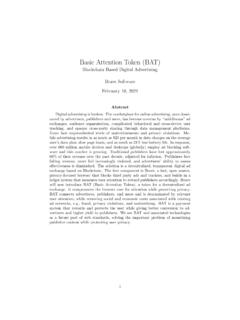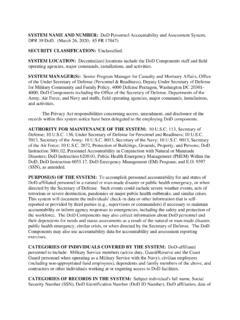Transcription of Descriptive and Substantive Representation in Congress ...
1 Descriptive and Substantive Representation in Congress :Evidence from 80,000 Congressional InquiriesShort Title: Descriptive Representation in CongressKeywords: inter-branch, Congress , bureaucracy, women, race and ethnicity, veteransKenneth Lowande1 University of MichiganMelinda Ritchie2 University of California, RiversideErinn Lauterbach3 University of California, RiversideMay 18, 201941 Assistant Professor, Department of Political Science. University of Michi-gan, Department of Political Science, 6658 Haven Hall, 505 South State Street, Ann Arbor, MI 481092 Assistant Professor, Department of Political Science. University ofCalifornia, Riverside, Department of Political Science 900 University Avenue, Riverside, CA Candidate, Department of Political Science. University of California,Riverside, Department of Political Science 900 University Avenue, Riverside, CA 925214A previous version was presented at the 2017 annual meeting of the Midwest Political Science Association,Chicago, IL.
2 We thank Ben Bishin, Daniel Butler, Jason Coronel, Jason MacDonald, Jennifer Merolla, BenNewman, and Sono Shaw for helpful comments and suggestions. Special thanks to CW5 Jeffrey Freelove,USA, and Substantive Representation in Congress :Evidence from 80,000 Congressional InquiriesA vast literature debates the efficacy of Descriptive Representation in legislatures. Though studiesargue it influences how communities are represented through constituency service, they are lim-ited since legislators service activities are unobserved. Using Freedom of Information Act (FOIA)requests, we collect 88,000 records of communication between members of the Congressand federal agencies during the 108th 113thCongress. These legislative interventions allowus to examine members follow through with policy implementation. We find that women,racial/ethnic minorities, and veterans are more likely to work on behalf of constituents withwhom they share identities.
3 Including veterans offers leverage in understanding the role of polit-ical cleavages and shared experiences. Our findings suggest that shared experiences operate as acritical mechanism for Representation , that a lack of political consensus is not necessary for sub-stantive Representation , and that the causal relationships identified by experimental work haveobservable implications in the daily work of Materials: The data , code, and any additional materials required to replicate all anal-yses in this article are available on the American Journal of Political Science Dataverse within theHarvard Dataverse Network, at: Count: 9,993 Well-intentioned laws may exacerbate political inequality if implemented in ways that fail to aidthe citizens they are intended to protect. Yet, studies of Representation focus on how constituentsare represented through the creation of law, overlooking its execution.
4 Accounts of federal agen-cies stalled implementation of the Civil Rights Act, mismanagement of workplace rights viola-tions, and falsification of veterans health care records demonstrate how cracks in the ideals ofdemocratic Representation can spread through policy implementation precariously beyond thepublic purview. Demands made by elected officials are an important means of know little about how Descriptive Representation impacts legislative interventionswith agencies on behalf of protected groups. This overlooked venue of Representation is partic-ularly important given the extensive role of federal agencies in policymaking and a history ofagencies neglecting groups of citizens they were entrusted to protect (Minta 2009, 2011). We shedlight on this phenomenon by examining whether members of Congress advocate on behalf ofprotected classes of citizens by communicating directly with the federal analysis is the first of its kind, possible only by obtaining and constructing a uniquedataset of over 88,000 congressional contacts assembled from a series of Freedom of InformationAct (FOIA) requests.
5 These data allow us to consider whether descriptively representative mem-bers of Congress ( racial and ethnic minorities, women, and veterans) advocate for underrep-resented communities by intervening with federal agencies implementing law. Do representativesfollow up on the policy interests of women, minorities, and veterans long after a bill s passage?Do they monitor agencies to ensure the rights of these communities are protected?By shedding light on these questions, records of legislative interventions in the bureaucracyoffer a unique approach to the study of Representation . Unlike voting records, bill sponsorship,speeches, and committee hearings which are influenced by both internal and external insti-tutional pressures representatives are comparatively less constrained in their communicationswith the federal bureaucracy (Grose 2011). Moreover, we build on novel experimental work thatinvestigates legislators responsiveness to constituents based on shared race and gender (Butler2014; Butler and Broockman 2011).
6 By analyzing interventions in the bureaucracy, we assesswhether the underlying causal relationships identified by these studies on state legislators haveobservable, systematic implications in the Congress . Put differently, our analysis assessesthe quality of legislative follow-through on behalf of these constituents rather than direct re-1sponses to the constituents find significant differences in the intervention patterns of female, minority, and veteran leg-islators that suggest Descriptive Representation leads to Substantive Representation in Congress . Ineach case, we find that in a given Congress , legislators are around 6-9 percentage points morelikely to contact federal agencies on behalf of constituents with whom they share backgroundcharacteristics, when compared to their non-veteran, male, or white colleagues. The differencesare most striking for women and men in Congress , where being represented by a female legislatoris associated with a 40% increase in the probability of relevant service.
7 These differences are robustafter accounting for factors influencing the selection of legislators, consistent across multiple mea-sures of Representation , and remain when limiting the analysis to split- Representation delegationsin the Senate a context that holds legislative district approach advances existing work on Descriptive Representation and has important impli-cations for future research. First, existing observational work focusing on legislative activity mustconsider numerous cross-cutting influences on legislative behavior. For example, race or gender-related legislation can be censored (via committees and party agenda setting, for example) beforeminority and women legislators register their votes. In contrast, our data demonstrate compara-tively unilateral action on the part of legislators not subject to chamber rules, logrolling, andnegative agenda control. This limits the number of potential explanations for observed , our approach offers a unique opportunity to test the implications of existing experimentalwork.
8 Our analysis is Descriptive and not intended to adjudicate between alternative causal path-ways of Substantive Representation such as strategic prioritization, personal bias, or constituentbehavior. Nonetheless, existing studies investigate these mechanisms, and each implies a similarrelationship between Descriptive and Substantive Representation . This study evaluates whetherone or more of these mechanisms has empirical implications that are detectable in the , this paper advances work on Descriptive Representation by including military veter-ans, which provides two important points of theoretical leverage. First, as Figure 1 indicates, thenumber of veterans in Congress has declined even while there is broad political consensus fa-voring veterans benefits trends which are typically the reverse in studies of the representationof women and racial/ethnic minorities. The fact that the data still reveal important differencesamong legislators suggests that the political conflict and partisan cleavages that can character-2ize other groups priorities is not necessary for Descriptive Representation to lead to substantiverepresentation.
9 Our findings, consistent across women, racial/ethnic minorities, and veterans,also suggest that the behavior of Descriptive representatives is not solely explained by historical,electoral, and other contextual accounts particular to a single group described in the extant liter-ature. Second, members vary in their degree of shared experience with veterans in ways that areobservable. This allows us to empirically assess this critical mechanism of Representation oftenreferenced in past work. In keeping with this explanation, we find that Substantive representationof veterans is particularly pronounced among legislators who have military service that is notconfined to reserves or state national guards. FIGURE 1 ABOUT HERE Descriptive and Substantive Representation in CongressWhile the extant literature typically focuses on Representation through lawmaking, protected classesof citizens may be most vulnerable at the implementation stage of policymaking.
10 Policy imple-mentation is particularly critical for underrepresented communities because it is less visible andoften decentralized , involving unelected bureaucrats in numerous agencies and at multiple levelsof government. Consequently, even when Congress passes a law, it does not ensure that imple-mentation will be swift or follow legislative intent. For example, research on the Civil Rights Actfound that Title VI, meant to prohibit organizations that discriminate from receiving federal fund-ing, was stalled by federal agencies (see Minta 2011, 41). Additionally, some sections of the VotingRights Act, overseen by state level bureaucrats, were unevenly implemented, depending on thestate and its history with civil rights (Marschall and Rutherford 2016). Even when an agency sprimary purpose is to serve protected groups, oversight is still , for instance,complaints during the 1980s that the Equal Employment Opportunity Commission (EEOC) wasineffective in managing cases of workplace civil rights violations (Minta 2011, 54) or the more re-cent findings that medical records had been falsified at Veterans Affairs (VA), compromising the1 While oversight does occur, publicly, in committees, this formal oversight is constrained by party leadership.







